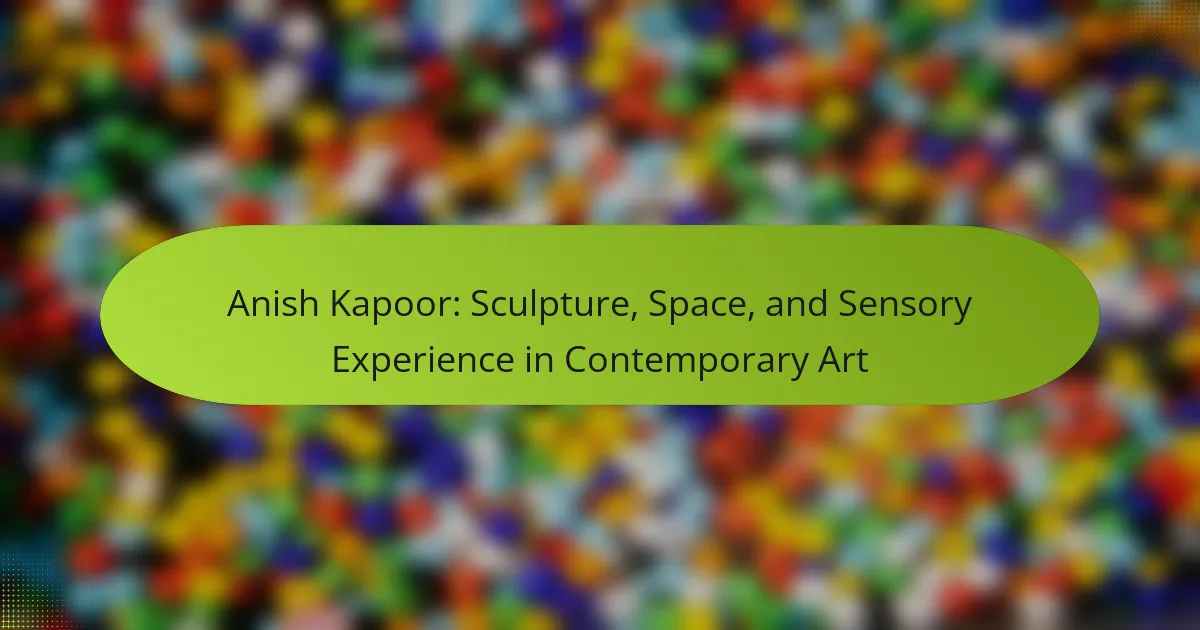Jeff Koons challenges traditional art boundaries by merging pop culture with commercialism. His works democratize art, making it accessible and engaging for diverse audiences. Koons critiques commodification while employing innovative techniques and large-scale installations. His unique approach influences modern exhibitions, inviting dialogue about the intersection of art and commerce.
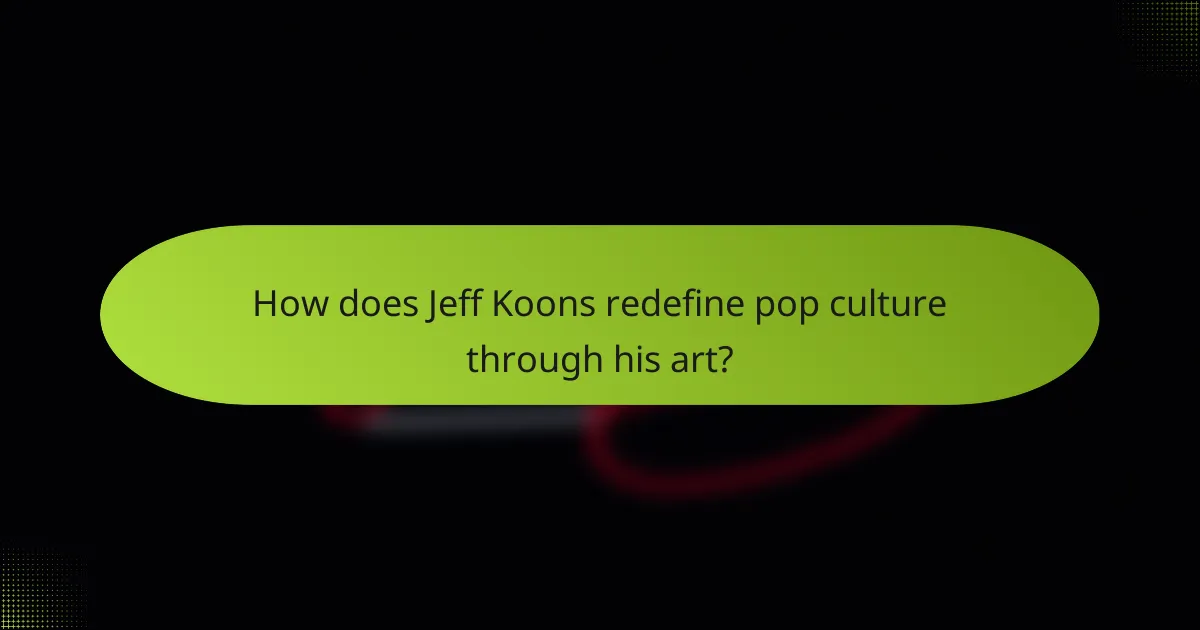
How does Jeff Koons redefine pop culture through his art?
Jeff Koons redefines pop culture through his art by merging commercialism with high art, creating accessible yet provocative pieces. His works, such as “Balloon Dog,” challenge traditional notions of art by incorporating everyday objects and consumer culture. This approach democratizes art, inviting broader audiences to engage with contemporary themes. Koons’ unique ability to blend irony and sincerity in his creations highlights the complexities of modern society, ultimately reshaping the landscape of pop culture in the art world.
What themes in Koons’ work resonate with contemporary society?
Jeff Koons’ work resonates with contemporary society through themes of consumerism, nostalgia, and the interplay of art and commercialism. His pieces often reflect the obsession with pop culture, blurring the lines between high art and mass production. This fusion challenges traditional notions of artistic value, making art accessible and relevant. Additionally, Koons’ use of familiar imagery evokes a sense of nostalgia, connecting with viewers’ shared experiences in a media-saturated world. His innovative techniques and bold aesthetics stimulate discussions about the role of art in a consumer-driven society.
Which iconic pieces exemplify Koons’ engagement with commercialism?
Jeff Koons’ iconic pieces that exemplify his engagement with commercialism include “Balloon Dog,” “Michael Jackson and Bubbles,” and “Puppy.” These works merge fine art with consumer culture, showcasing bright colors and familiar forms. “Balloon Dog,” made from stainless steel, reflects the playful nature of commercial objects while challenging traditional art values. “Michael Jackson and Bubbles” critiques celebrity culture, blending kitsch with high art. “Puppy,” a floral sculpture, symbolizes the commercialization of art through its massive scale and public appeal. Each piece highlights Koons’ unique ability to transform everyday objects into high-value art.
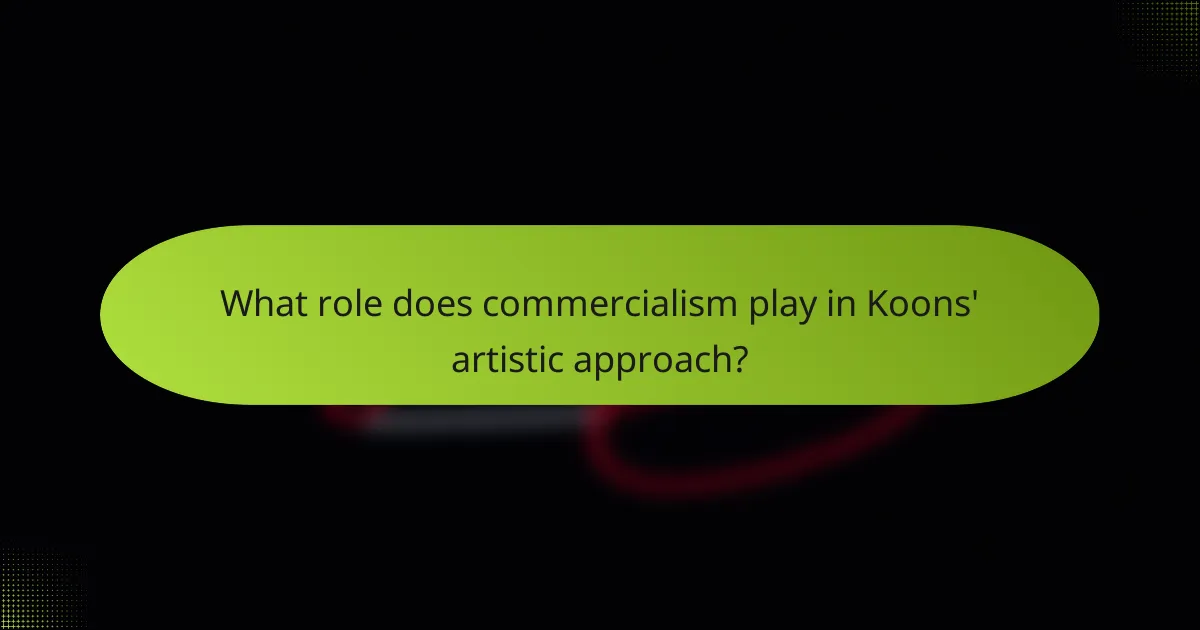
What role does commercialism play in Koons’ artistic approach?
Commercialism plays a pivotal role in Jeff Koons’ artistic approach by merging art with consumer culture. His work often reflects and critiques the commodification of art, emphasizing the relationship between high art and mass production. Koons utilizes commercial techniques, such as bright colors and familiar imagery, to engage a broad audience. This approach not only enhances accessibility but also challenges traditional notions of artistic value. By blurring the lines between art and commerce, Koons redefines the purpose and experience of contemporary art.
How does Koons’ use of mass production challenge traditional art forms?
Jeff Koons’ use of mass production challenges traditional art forms by democratizing art accessibility and questioning originality. His works, often produced in multiples, blur the lines between fine art and commercial products. This approach critiques the notion of the unique masterpiece and elevates consumer culture as a legitimate artistic subject. By utilizing industrial techniques, Koons transforms everyday objects into high art, prompting viewers to reconsider the value and meaning of art in a capitalist society.
What are the implications of Koons’ collaborations with brands?
Jeff Koons’ collaborations with brands blur the lines between art and commerce, enhancing visibility and accessibility. These partnerships elevate brand identity while reinforcing Koons’ status as a cultural icon. As a result, they challenge traditional perceptions of artistic value and authenticity. Collaborations expand audience engagement, allowing contemporary art to reach broader demographics.
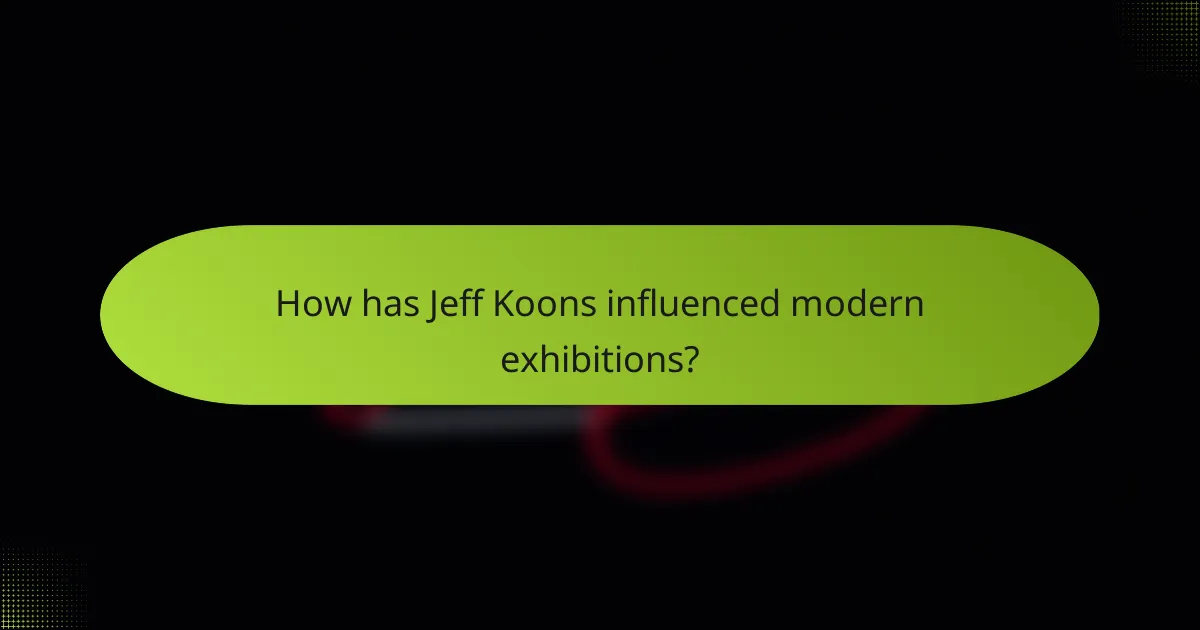
How has Jeff Koons influenced modern exhibitions?
Jeff Koons has significantly influenced modern exhibitions by merging pop culture, commercialism, and artistic innovation. His work challenges traditional boundaries, making art more accessible and engaging for diverse audiences. Koons’ large-scale installations, such as “Balloon Dog,” exemplify this trend by transforming everyday objects into monumental art pieces. His emphasis on consumerism invites dialogue about the intersection of art and commerce, pushing curators to rethink exhibition strategies. As a result, contemporary exhibitions increasingly feature interactive and immersive experiences that reflect Koons’ impact on the art world.
What innovative exhibition strategies has Koons employed?
Jeff Koons employs innovative exhibition strategies that engage audiences through immersive experiences and interactive installations. He often integrates commercial elements, blurring the line between art and consumer culture. Koons utilizes large-scale sculptures and vibrant colors to attract attention, creating a spectacle that invites viewer participation. His exhibitions frequently leverage social media to enhance visibility and audience interaction, making the art accessible beyond physical spaces.
How do his exhibitions reflect broader trends in the art world?
Jeff Koons’ exhibitions showcase the intersection of commercialism and artistic innovation, reflecting broader trends in the art world that prioritize accessibility and consumer culture. His work often critiques and embraces mass production, highlighting the blurred lines between high art and commercial products. By using familiar pop culture imagery, Koons engages a wider audience, aligning with contemporary movements that value inclusivity in art. This approach mirrors the increasing acceptance of commercial influences in the artistic landscape, as seen in the rise of artists who integrate branding and consumerism into their work.
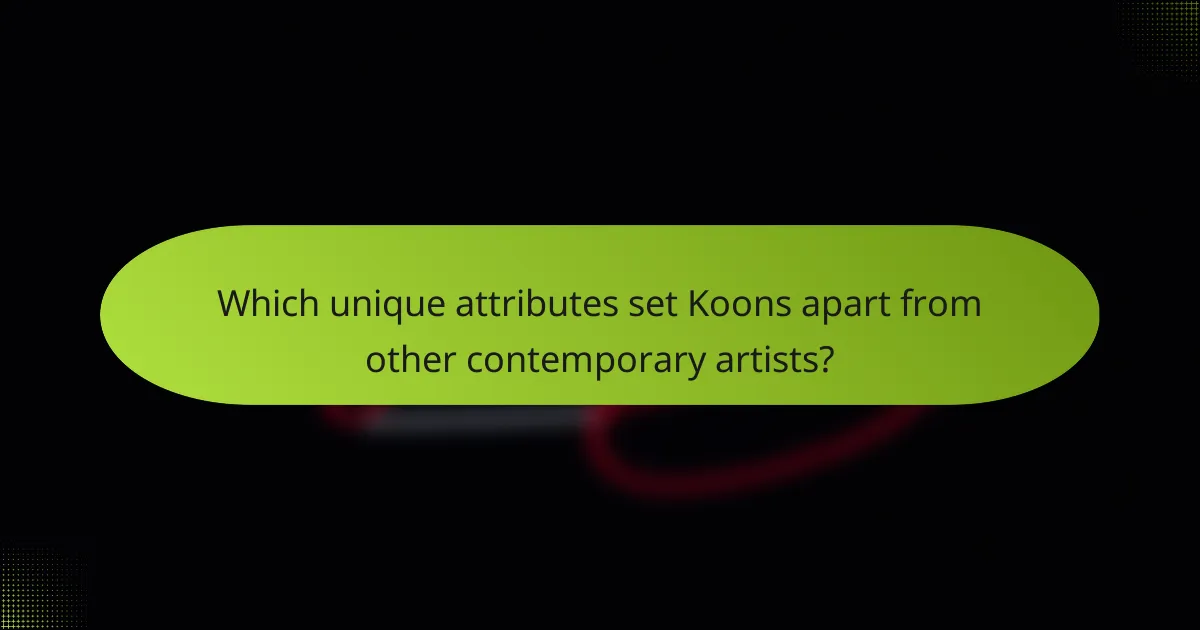
Which unique attributes set Koons apart from other contemporary artists?
Jeff Koons is distinguished by his unique blend of commercialism and high art, pushing boundaries in contemporary art. His use of everyday objects, like balloon animals, transforms them into monumental sculptures, challenging traditional artistic norms. Koons also employs a collaborative approach, working with artisans and manufacturers, which sets him apart from many artists who create independently. His ability to merge pop culture with fine art creates a distinctive dialogue that resonates with a broad audience, making his work both accessible and provocative.
What is the significance of Koons’ choice of materials and mediums?
Jeff Koons’ choice of materials and mediums is significant for its boldness and commercial appeal. He often utilizes stainless steel and inflatable materials, which create a sense of playfulness and reflect consumer culture. This choice emphasizes the contrast between fine art and mass production. Additionally, the reflective surfaces of his sculptures engage viewers, inviting them to see themselves within the art. Koons’ work challenges traditional notions of artistry by integrating everyday objects, thus blurring the lines between high art and commercialism.
How does Koons’ background inform his artistic voice?
Jeff Koons’ background significantly shapes his artistic voice through his embrace of commercialism and pop culture. Growing up in a suburban environment, he developed an appreciation for consumer products and mass media. This upbringing influences his work, which often blurs the line between high art and commercial appeal. His education at the School of the Art Institute of Chicago and his exposure to various art movements further inform his innovative techniques. Koons’ unique ability to transform everyday objects into art pieces highlights his rare talent for engaging audiences with familiar imagery.
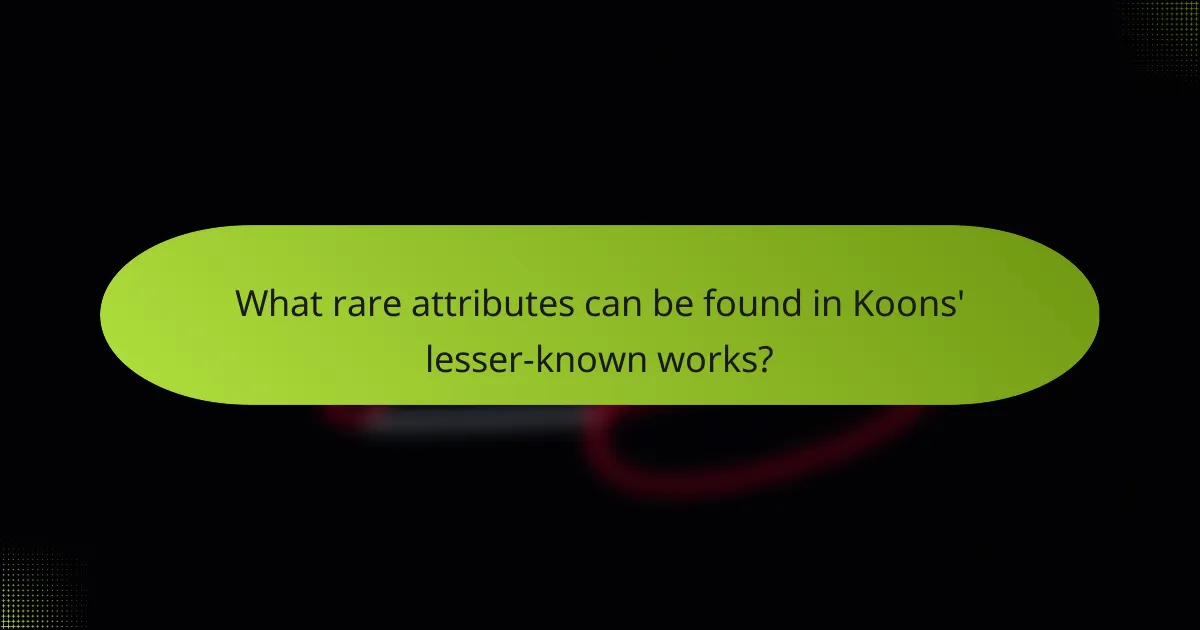
What rare attributes can be found in Koons’ lesser-known works?
Jeff Koons’ lesser-known works often feature rare attributes that reflect his innovative approach. These include unexpected materials, such as inflatable sculptures made from advanced polymers, and unique interactive elements that engage audiences in unconventional ways. Additionally, some pieces incorporate ephemeral aspects, like installations that change over time or rely on viewer participation for completion. These rare traits distinguish his lesser-known works from more mainstream pieces, showcasing his commitment to pushing artistic boundaries.
Which experimental projects showcase Koons’ artistic risks?
Jeff Koons’ experimental projects often push artistic boundaries through innovative materials and concepts. Notable examples include “Balloon Animals,” which challenge perceptions of value and art through large-scale, shiny sculptures. Another significant project is “Michael Jackson and Bubbles,” blending pop culture with fine art, provoking discussions on celebrity and consumerism. His “Gazing Ball” series invites viewers to engage with traditional art while reflecting on contemporary themes. Each project exemplifies Koons’ unique approach to merging commercialism with artistic expression.
How do these rare works contribute to his overall legacy?
Rare works by Jeff Koons significantly enhance his legacy by showcasing his artistic innovation and commercial appeal. These unique pieces often challenge traditional notions of art, blending high culture with pop culture. For instance, his balloon animal sculptures exemplify this fusion, attracting both art collectors and the general public. This accessibility contributes to his reputation as a pivotal figure in contemporary art. Additionally, the rarity of these works elevates their value and intrigue, solidifying Koons’ status in the art world.
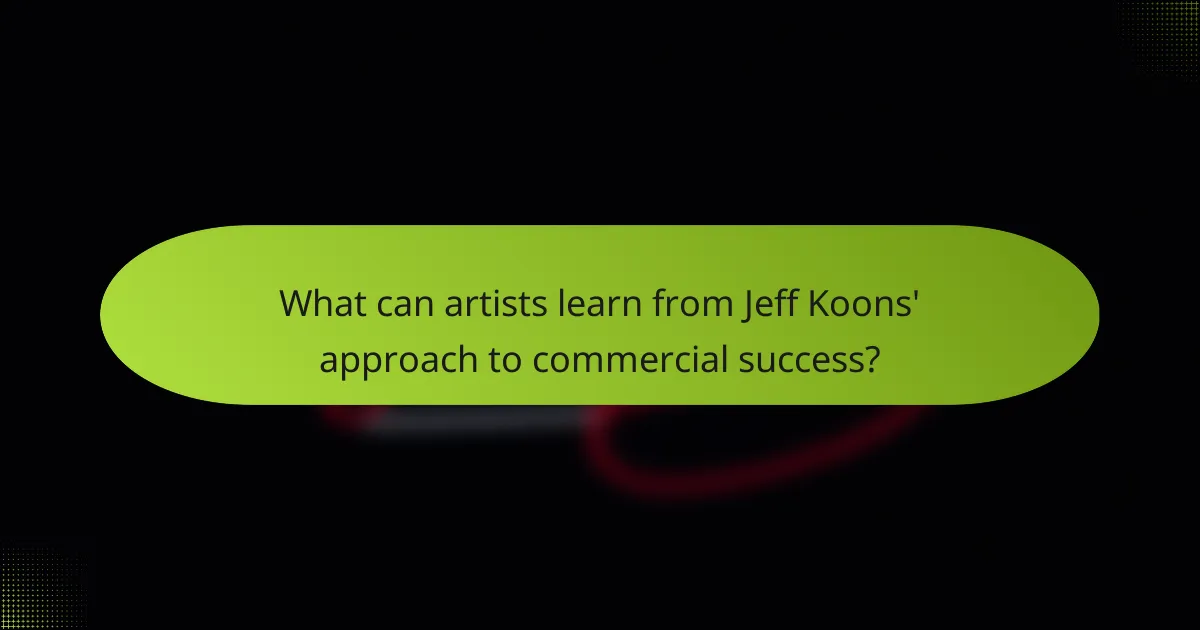
What can artists learn from Jeff Koons’ approach to commercial success?
Artists can learn the importance of blending commercial appeal with artistic vision from Jeff Koons. His approach emphasizes creating accessible art that resonates with a broad audience while maintaining innovative techniques. Koons leverages pop culture, transforming everyday objects into high art, which demonstrates the potential for profitability in artistic ventures. This strategy encourages artists to explore market trends and adapt their work to engage wider demographics without compromising their unique artistic voice. By embracing commercialism, artists can find new avenues for success and visibility in a competitive landscape.
Which strategies can emerging artists adopt from Koons’ career?
Emerging artists can adopt several strategies from Jeff Koons’ career. They should embrace commercialism, leveraging popular culture to reach broader audiences. Collaborating with brands can enhance visibility and create unique art experiences. Additionally, artists should prioritize innovation, experimenting with new materials and techniques to differentiate their work. Engaging in public exhibitions and installations can also increase exposure and foster community connections. Finally, maintaining a strong personal brand can help cultivate a loyal following and drive market interest.
What common mistakes should artists avoid when navigating commercialism?
Artists should avoid compromising their vision for commercial appeal, neglecting their audience, and failing to understand market dynamics. These mistakes can dilute artistic integrity and hinder long-term success. Additionally, over-reliance on trends instead of personal style can lead to a lack of authenticity. Engaging with the art community and maintaining a clear artistic identity are crucial for navigating commercialism effectively.
